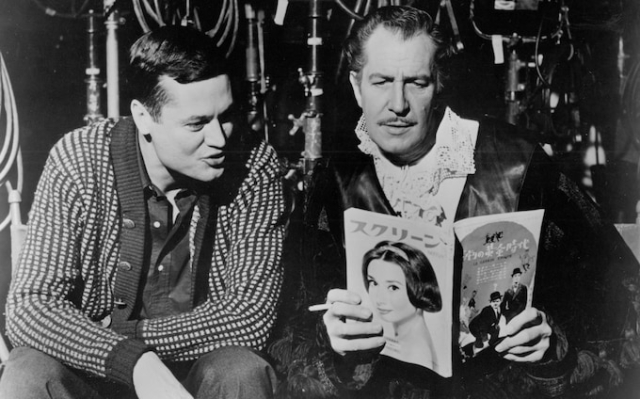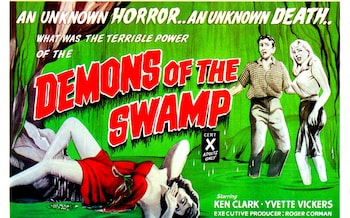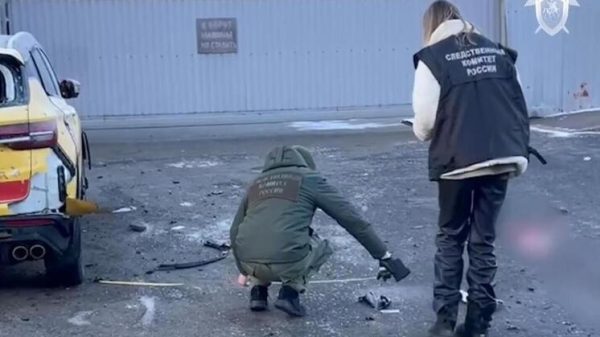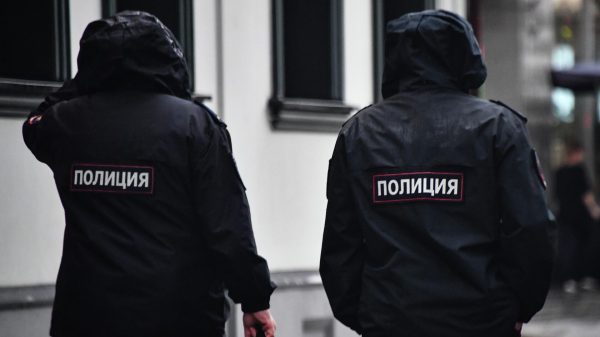 Director Roger Corman (left) on the set of The Pit and the Pendulum (1961) with Vincent Price. Photo: Rex/Everett Collection < p>Roger Corman, director and producer of hundreds of films including 1960's Little Shop of Horrors, has died at the age of 98. In this 2013 interview from The Telegraph archives, he spoke candidly about his long career and the state of modern horror cinema. /p>
Director Roger Corman (left) on the set of The Pit and the Pendulum (1961) with Vincent Price. Photo: Rex/Everett Collection < p>Roger Corman, director and producer of hundreds of films including 1960's Little Shop of Horrors, has died at the age of 98. In this 2013 interview from The Telegraph archives, he spoke candidly about his long career and the state of modern horror cinema. /p>
At 87, Roger Corman is a brilliant gentleman. He walks with a strong stoop and speaks in careful, precise sentences, taking great pains not to miss a word. It's hard to believe the career this gentle legend has had, not to mention the career he has given others — he gave Martin Scorsese, Francis Ford Coppola, Peter Fonda, Jonathan Demme, Pam Grier, Ron Howard, James Cameron and Jack Nicholson their first breaks . .
Along the way, Corman wrote several films, directed 56, appeared in a couple dozen, mostly uncredited bit parts, and produced about 400 films in one capacity or another. The titles include some of the most startlingly bleak in film history, like 1957's Attack of the Crab Monsters, or 1959's The Wasp Woman, or 1977's Ilsa, the Siberian Tigress. Surprisingly, he's still working—apparently there's a movie in production called Dance with the Vampire—even though he hasn't directed a movie since 1990's Frankenstein Unchained.
Corman is in London for an on-stage interview as part of the BFI's grand goth season. He uses the invitation as an excuse for a short break in Europe with his wife Julie, a fellow producer whom he married in 1970. And he seems happy to share all the anecdotes he's collected along the way.
There are so many stories about Corman that I first wonder if there are any he'd like to debunk. Did he really tell Coppola not to go to the Philippines to film Apocalypse Now?
«Because I was making films there myself, I said, 'Francis, don't go!' Your rainy season is coming.” He said, «Oh, it's going to be a rainy picture.» But this is not rain as we know it. It starts in May and continues until October. His set was destroyed. And the insurance paid depending on the rainy season. But there was no monsoon! It was normal July weather. He returned in good weather and made the film.»
 'Unknown Horror': 1959 poster for Roger Corman's film «Demons of the Swamp»
'Unknown Horror': 1959 poster for Roger Corman's film «Demons of the Swamp»
It's incredible how many of these Oscar-winning American film careers arose under the auspices of American International Pictures (AIP), for which Corman was an in-house director and producer, and New World Pictures, the production and distribution company for which he worked. founded personally in 1970 with his brother Gene. He produced Coppola's Dementia 13 (1963), Bogdanovich's Goals (1968), Scorsese's Boxcar Bert (1972) and Demme's Cage Heat (1974). All interned with Corman for a movie or two and then moved on to their famous studio heyday. But he remained on good terms with everyone.
Jack Nicholson was a different case. They met at acting classes in Hollywood, where Corman was scouting for talent. The aspiring impresario gave Nicholson the lead role of a juvenile delinquent in his screen debut, Crybaby Killer (1958), and over the next 10 years used him in a string of car-running sleazes, playing rebel bikers and endless criminals. terrorized gothic chiller heroes. Nicholson's career stubbornly refused to take off until his mainstream breakthrough with Easy Rider (1969), at which point it was time for the two to go their separate ways. But there was more to it than just a professional connection: in the 2011 documentary Corman's World, Nicholson spontaneously cries when talking about Corman's importance in his life.
The films Corman has made himself began as the definition of sparseness, but sometimes he feels their raw qualities are exaggerated. “The myth is that when I directed, I always did the first take. I usually did two, three, four takes. The first take is usually not quite what you want.”
There are a couple of directors who are known to love using first takes — Clint Eastwood, Jean-Luc Godard. And then at the opposite end of the spectrum there are Stanley Kubricks, obsessively demanding more and more.
“Jack Nicholson used to do a second or third take with me,” recalls Corman. “Kubrick did more than 100 takes for one scene in The Shining. I don't remember exactly, but there were 120, 130 or so takes. And Jack is a good guy, he stood and repeated his lines 120, 130 times. And he told me that after that he came up to Kubrick and said: “Stanley, I'm with you always, but I want you to know that my peak usually falls on the 70th or 80th take.”
As Corman's name began to mean something, he was entrusted with higher budgets and began work on a more ambitious series of projects — eight period adaptations of Edgar Allan Poe between 1959 and 1964, all but one of which starred Vincent Price. Noted for their striking use of color and wide screen — The Masque of the Red Death (1964) was even directed by Nicolas Roeg — they proved his talent as a horror director and hold up eerily well as the definitive film versions of Poe. “I learned on the job,” he explains, “so it wasn’t a specific change in technique, it was just learning from film to film.”
 Vincent Price in Roger Corman's film The Masque of the Red Death. Photo: Entertainment Pictures/Alamy Stock Photo
Vincent Price in Roger Corman's film The Masque of the Red Death. Photo: Entertainment Pictures/Alamy Stock Photo
How does he feel about modern horror films? “The horror cycle is more explicit now than when I was doing horror films. Previously, the word was “indirectness.” We suggested, we implied horror with editing, camera movements and storyline, the horror built and built. Now you'd rather just cut someone's arm off and the blood will splatter across the screen and you'll get a sense of horror from it. I think this will start to fade. I've been around long enough to see cycles begin, build and end. One director cuts off someone's hand at the wrist, another — at the shoulder. It's getting creepier and creepier. The audience will react and turn away from it.”
In 1998, Corman published his autobiography, How I Made a Hundred Movies in Hollywood and Never Lost a Dime. The title was not chosen by him, but by the publisher. “I have made over a hundred films. And I lost a couple of times! I called the editor and said that the title was not quite right, and he asked: “Does the title of each of your films reflect what was in it?” I said, «Use whatever name you like!»
One film that did lose money (in fact, it was Corman's first failure) was his provocative 1962 drama The Intruder, starring William Shatner as a segregationist who comes to a small Southern town to stir up racist hostility among the locals. residents. Not only did the crew receive death threats during the filming of the film once the townspeople realized that Shatner's character was anything but the hero of the film, but no one ultimately came to see it.
Corman was punished. “It changed a lot of my ideas about filmmaking. It has been to festivals and received great reviews. One New York critic said: «The Intruder is a great credit to the entire American film industry.» And it was the first film I made after losing money! I analyzed it. Even though it received universal acclaim from critics and so on, it was too much of a lesson to try to teach the public. I had to go back to having fun.”
“Thanks to this, I have a style. I tried to make the film on two levels. On a surface level it could be, say, a gangster film. But on a subtextual level, it could be connected to some thing or concept that was important to me. Maybe some people will understand these two levels, maybe not, but that's how I prefer to work.»
Corman fans are especially fond of a film called The Terror (1963) — the fastest of his fast films, the cheapest of his cheap films, and a film that demonstrates his huckster's resourcefulness in extracting money from an old rope. It was shot entirely on sets left over from other AIP productions that year, such as The Raven and The Haunted Palace. Boris Karloff stayed in California for a couple more days, finishing filming the first. But I have to let Corman explain.
 Roger Corman at the 2023 Cannes Film Festival. Photo: AFP via Getty Images
Roger Corman at the 2023 Cannes Film Festival. Photo: AFP via Getty Images
“The whole picture was made just because it rained on Sunday. We were supposed to play tennis. I called screenwriter Leo Gordon. We developed the storyline and Leo only wrote the two days in which I used Jack Nicholson and Boris Karloff before Boris returned to England. Due to my obligations to the Union, I was unable to film the rest of the picture. Coppola shot for a few days and then got a job at Warner Bros. and his career took off. Monte Hellman directed a little, Jack Hill directed a little. And on the last day, Jack Nicholson said to me: “Roger, every idiot in town shot a part of this picture, let me shoot one day!” And I said, “Come on, be a director for one day.” /p>
“We edited it all together and, frankly, each director had their own interpretation and the picture didn't make any sense. I was making another movie, so I wrote a short scene and had Jack Nicholson throw his co-star Dick Miller against the wall. He said: “I have been lied to since I came to this castle. Now tell me what’s going on!” At this point, Dick Miller explains what the picture is about. People really took it seriously and tried to figure it out, but there was no plot to this picture. This did not stop the company from making money.»
Newcomers to Corman's deliciously messy world of filmmaking may be surprised to learn of his importance as an arthouse distributor. He achieved great success in America with Fellini's Amarcord (1974) and Volker Schlöndorff's The Tin Drum (1979), both of which won the Academy Award for Best Foreign Film, and Bergman's Cries and Whispers (1973). , which was even nominated for Best Picture. /p>
While it's hard to imagine the dour Swede directing, say, Teenage Caveman (1958), there is actually a certain kinship in themes and style between Bergman and Corman, who delayed making The Masque of the Red Death because of the «Seventh». «Seal,» with its strikingly similar vision of Death stalking the earth, has just been released.
I tell him that Scorsese wrote it down, at least as newsreel Peter Biskind tells it in «Easy Riders.» mad bulls.» for preferring Peter Fonda's biker film Wild Angels (1966), directed by Corman, to Bergman's Wild Strawberries (1957). Corman laughs. “I think Marty sometimes says things to scare people. But we can certainly agree that Wild Angels had more action than Wild Strawberries.






















































Свежие комментарии